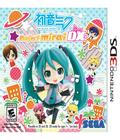For those unfamiliar with the concept of a vocaloid, think of them as a Japanese version of the band Gorillaz. Both are virtual instead of real, with the former being a rendered 3-D model and the latter being a 2-D animated model. Both have famous singers behind them, though vocaloids have pieces of a famous singer put together to form words instead of having a singer perform each song normally. Also, unlike the rock band, vocaloids tend to have songs created by fans. Of these creations, Hatsune Miku is one of the most popular, and that popularity was enough for Sega to start releasing her rhythm titles in North America. So far, only the Sony platforms had the chance to host those games, but their success gave Sega the notion to consider a release on the 3DS in the form of Hatsune Miku: Project Mirai DX.
At its core, the game plays out like any other rhythm title. Your marker goes over a button, and you must try your best to hit it at the right moment to score the most points. The symbol markers are still all over the screen, but not they're connected by a line, so the player has some help in anticipating where the next one will pop up. Like the Sony versions, the game relies on you hitting face buttons or their respective directions to score points, and while it also has you hitting them in tandem on some notes, the prompt to do so is clearer since it shows both a button and a direction instead of a solid directional arrow. Note taps and sustained holds are here, but the scratching portions are gone. Instead, you can rotate the Circle Pad when doing sustained holds on rainbow notes to score bonuses.
Players can also choose to play the game using only the touch-screen, and that changes things a bit. In this mode, the touch-screen is divided into a maximum of three colors, and players must tap or hold on those corresponding sections when the given symbol appears on the play field. Making circles on the touch-screen acts as an analog for the Circle Pad in the sustained rainbow note sections, but this control method is also the only one where scratching returns. You must swipe the screen in specific directions to register the hit.
The introduction of dual control schemes actually opens up the game in terms of difficulty. Even on the easiest levels, you must keep track of a large number of buttons, and though the game isn't as likely to fail you as the PS3/Vita versions, if you aren't hitting the notes perfectly, it can be difficult to garner decent scores by using the button control scheme. Switching to touch controls makes things much easier, and averaging S ranks on the highest difficulty for each song is completely feasible. No matter how you decide to play, progress is saved separately for each control method, and while this doesn't mean that you have to unlock new songs twice, it does mean that you need to pass that method's normal difficulty level before moving on to the hard level.
Speaking of songs, this entry boasts the biggest lineup yet with 47 tunes. There are a good deal of songs that have appeared in previous entries, like "Kokoro" and "Mousou Sketch," but there are also 19 new entries, such as "1925," "Electric Love" and "Sweet Magic." Unlike the Sony versions, you're playing through the whole song instead of something edited for the game. You're not going to notice any difference with the songs when compared to their original format. Also, whichever track you select is presented in a themed stage format instead of a music video format. Backgrounds and stage elements change, so it's not like you're dancing and singing on a stage, but you don't get as many radical scene changes as the song goes on. The result is that the songs are more upbeat, so there are no ballads for Miku and company this time around.
Graphically, Project Mirai DX ditches the realistic proportions of the vocaloids in favor of the Nendoroid style. Designed to emulate a chibi style with large heads, the vocaloids look younger and almost child-like. It was a good decision to do this, since the faces can be more expressive without drowning in the jagged lines and muddied textures that would've been present with realistically proportioned models. Elsewhere, the animations are well done and the backgrounds are cute.
As a rhythm game, the controls are easy to grasp, and there are very few instances where presses or swipes aren't read correctly. The music is very catchy, and you'll find a few favorites in the list unless you don't enjoy j-pop. It also counters some of the decisions made by other rhythm games by having a great deal of the song list locked away until you beat the unlocked songs. What is normally an annoyance in a rhythm game with a multiplayer focus becomes a blessing in a single-player game, since it means the player has plenty to do before exhausting all of the content.
However, the game seems to emphasize the vocaloids rather than the rhythm aspect, relegating the main activity to a small stamp on the main menu. You wouldn't be faulted for thinking that the title's focus is on fostering a relationship with and taking care of your miniature vocaloid. It starts off with you choosing a vocaloid and choosing a residence for them. Then your character can finally go about their business in the top screen while you use the bottom screen to figure out what to do.
Before mentioning what can be done, it should be noted that some of the life simulator elements that were in the Sony versions are missing in the 3DS entry. The most notable is the touch mechanic, where you can poke and pet the vocaloid to elicit a response. Gamers were divided on the mechanic, as people found it to be equally cute and disturbing. There's no need to maintain a vocaloid's happiness level, and while removing consequences for your actions may make the activities feel pointless to some, it also means that those who didn't care for it won't be forced to use it to progress. What you're left with are activities that succeed in putting your vocaloid in a cute or adorable light.
Once you leave your abode, an extensive amount of activities await. You can create dance routines for your vocaloid, though those are restricted to the roster of songs in the game, as there's no way to create your own songs from scratch. The dances can either be done in the music video or in AR mode, provided you printed out the site's copies of the cards or obtain them via a physical version of the game. The act of creating dance routines is simple, since you can choose moves and stamp them in the timeline. As fun as they are to make, the only drawback is that you can't share the routines online, relying instead on StreetPass to share your creation with others.
Aside from dance creation, you can create short little tunes that other StreetPass users will hear when they view your profile. There are a number of instruments that can be used, and creation requires a simple tapping of notes. The title allows you to view videos of unlocked songs without the note elements getting in the way. You can also add your comments to the videos that'll scroll along, similar to how comments are seen in Nico Nico Douga clips. There's also the ability to buy food for your vocaloid so you can watch them eat, and you can also buy outfits for them using the money earned from completing songs. You can even purchase decorations for your vocaloid's residence, like posters, jukeboxes, and tiny statues of themselves.
Beyond the main rhythm section, perhaps the most intriguing element of Project Mirai DX is the minigames. There's a themed version of Reversi (named Mikuversi), the classic board game where you must fill up the board with more of your colored tokens than your opponent. The difficulty options are customizable, and while this is nothing more than the basic game with your vocaloid expressing his or her emotions on the top screen, it is still fun to play. More fascinating is Puyo Puyo 39, Sega's classic puzzle game where you match four colored jelly creatures in a row in a restricted field. The versus game allows you to play against human players or against other vocaloids, and you must defeat every one of them on your journey to the top. There's an image of your vocaloid playing a concert at the bottom of the screen, and the musical accompaniment consists of actual songs from the game. Both games, despite their age, are fun and addictive enough that you might forget about the rhythm game for a while.
If you aren't really big on the extracurricular activities, Project Mirai DX still manages to fascinate the player through your vocaloid's actions. Have them walk around their decorated abodes, and they'll interact with their belongings. Give them money, and they'll react with happiness. They'll also use that money to order goods or put it into their savings, which is admirable to see. They'll even have interactions with other vocaloids that come to visit. Again, all of these things have no real impact on the game other than to make the vocaloids look cute, and it succeeds every single time.
Hatsune Miku: Project Mirai DX is an excellent game. As expected, the rhythm game has catchy tunes, and the various control methods ensure that a wider audience can enjoy the title. The things you can do outside of the main game are nice, and the inclusion of the two minigames is enough to make you feel like you underpaid for the title. Combined with a great presentation, this is perhaps the best rhythm game on the system to date. Genre fans should definitely run out and snag Project Mirai DX.
Score: 9.0/10
More articles about Hatsune Miku: Project Mirai DX










 Hatsune Miku: Project Mirai DX is a 3D rhythm game featuring 48 full length versions of fan-favorite songs with multiple game modes and play styles.
Hatsune Miku: Project Mirai DX is a 3D rhythm game featuring 48 full length versions of fan-favorite songs with multiple game modes and play styles.





















































